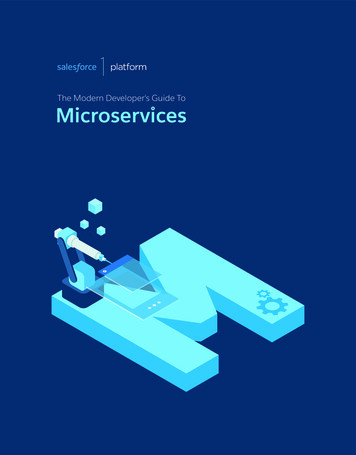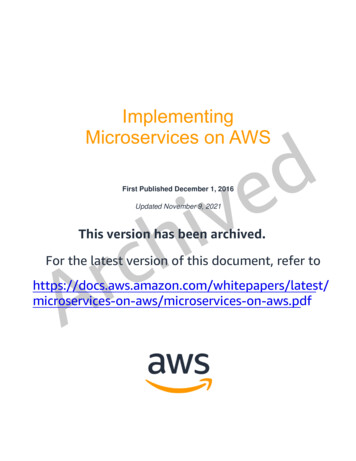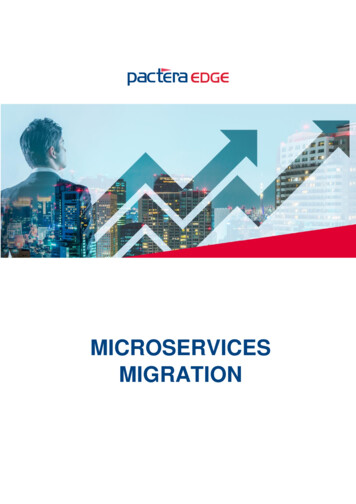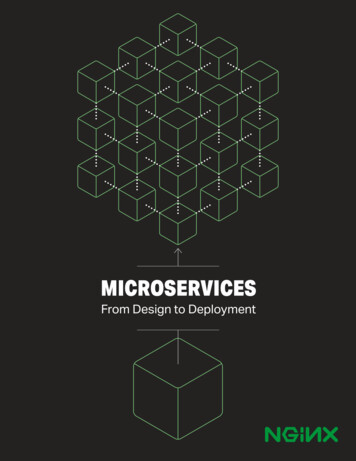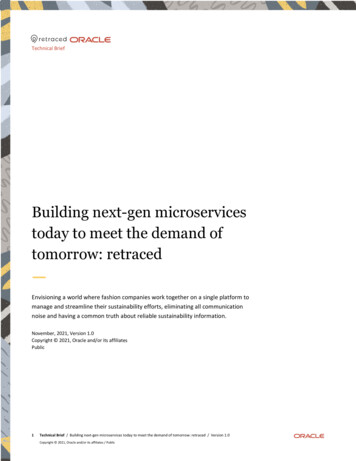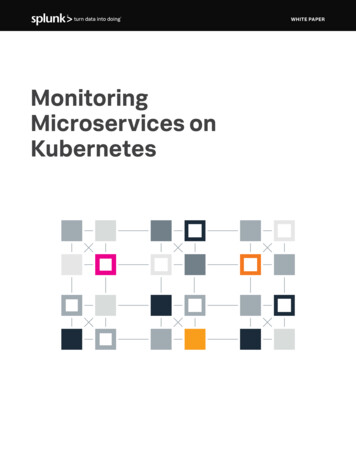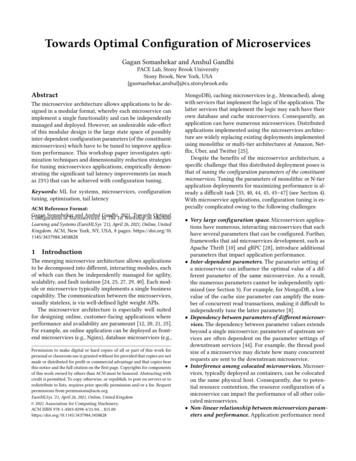
Transcription
gn Principles for Distributed SystemsJonas Bonér
Reactive MicroservicesArchitectureDesign Principlesfor Distributed SystemsJonas BonérBeijingBoston Farnham SebastopolTokyo
Reactive Microservices Architectureby Jonas BonérCopyright 2016 Jonas Bonér. All rights reserved.Printed in the United States of America.Published by O’Reilly Media, Inc., 1005 Gravenstein Highway North, Sebastopol, CA95472.O’Reilly books may be purchased for educational, business, or sales promotional use.Online editions are also available for most titles (http://safaribooksonline.com). Formore information, contact our corporate/institutional sales department:800-998-9938 or corporate@oreilly.com.Editor: Brian FosterProduction Editor: Colleen ColeCopyeditor: Colleen ToporekMarch 2016:Interior Designer: David FutatoCover Designer: Karen MontgomeryIllustrator: Kevin WebberFirst EditionRevision History for the First Edition2016-03-15: First ReleaseThe O’Reilly logo is a registered trademark of O’Reilly Media, Inc. Reactive Microser‐vices Architecture, the cover image, and related trade dress are trademarks of O’ReillyMedia, Inc.While the publisher and the author have used good faith efforts to ensure that theinformation and instructions contained in this work are accurate, the publisher andthe author disclaim all responsibility for errors or omissions, including without limi‐tation responsibility for damages resulting from the use of or reliance on this work.Use of the information and instructions contained in this work is at your own risk. Ifany code samples or other technology this work contains or describes is subject toopen source licenses or the intellectual property rights of others, it is your responsi‐bility to ensure that your use thereof complies with such licenses and/or rights.978-1-491-95934-3[LSI]
Table of Contents1. Introduction. . . . . . . . . . . . . . . . . . . . . . . . . . . . . . . . . . . . . . . . . . . . . . . . 1Services to the RescueSlicing the MonolithSOA Dressed in New Clothes?3352. What Is a Reactive Microservice?. . . . . . . . . . . . . . . . . . . . . . . . . . . . . . . 7Isolate All the ThingsAct AutonomouslyDo One Thing, and Do It WellOwn Your State, ExclusivelyEmbrace Asynchronous Message-PassingStay Mobile, but Addressable811121317223. Microservices Come in Systems. . . . . . . . . . . . . . . . . . . . . . . . . . . . . . . 27Systems Need to Exploit RealityService DiscoveryAPI ManagementManaging Communication PatternsIntegrationSecurity ManagementMinimizing Data CouplingMinimizing the Cost of CoordinationSummary283032343538414247iii
CHAPTER 1IntroductionWe change a monolithic system only when we have no other choice.Rather than swiftly capture opportunity, we ponder if it’s reallyworth upsetting the delicate balance of the house of cards we callour enterprise system. Often the opportunity quickly disappears,captured by a faster company, as in Figure 1-1.In the new world, it is not the big fish which eats the small fish, it’sthe fast fish which eats the slow fish.—Klaus SchwabFigure 1-1. Slow fish versus fast fishMicroservices-Based Architecture is a simple concept: it advocatescreating a system from a collection of small, isolated services, eachof which owns their data, and is independently isolated, scalable andresilient to failure. Services integrate with other services in order toform a cohesive system that’s far more flexible than the typical enter‐prise systems we build today.1
Traditional enterprise systems are designed as monoliths—all-inone, all-or-nothing, difficult to scale, difficult to understand and dif‐ficult to maintain. Monoliths can quickly turn into nightmares thatstifle innovation, progress, and joy. The negative side effects causedby monoliths can be catastrophic for a company—everything fromlow morale to high employee turnover, from preventing a companyfrom hiring top engineering talent to lost market opportunities, andin extreme cases, even the failure of a company.The war stories often sound like this: “We finally made the decisionto make changes to our Java EE application, after seeking approvalfrom management. Then we went through months of big up-frontdesign before we eventually started to build something. But most ofour time during construction was spent trying to figure out what themonolith actually did. We became paralyzed by fear, worried thatone small mistake would cause unintended and unknown sideeffects. Finally, after months of worry, fear, and hard work, thechanges were implemented—and hell broke loose. The collateraldamage kept us awake for nights on end while we were firefightingand trying to put the pieces back together.”Does this sound familiar?Experiences like this enforce fear, which paralyzes us even further.This is how systems, and companies, stagnate. What if there was abetter way?You’ve got to start with the customer experience and work backtowards the technology.—Steve JobsThe customers of Microservices are the organizations who invest insystems, so let’s start with the customer: developers, architects, andkey stakeholders.Do you prefer to work on a large system and have a small impact, orwork on a small, well-defined part of the system and have a largeimpact? Do you do your best work in a large bureaucratic group, oron a small team of people that you know and trust? Do you do yourbest work when delegated to, or when you’re given room to thinkcreatively and build useful things? Enter Microservices.2 Chapter 1: Introduction
Services to the RescueAlthough the world is full of suffering, it is also full of theovercoming of it.—Helen KellerMicroservices are the next design evolution in software not purelybecause of technical reasons. The ideas embodied within the termMicroservices have been around well before our first venture intoService Oriented Architecture (SOA). Certain technical constraintsheld us back from taking the concepts embedded within the Micro‐services term to the next level: single machines running single coreprocessors, slow networks, expensive disks, expensive RAM, andorganizations structured as monoliths. Ideas such as organizing sys‐tems into well-defined components with a single responsibility arenot new.Fast forward to 2016. The technical limitations holding us backfrom Microservices are gone. Networks are fast, disks are cheap(and a lot faster), RAM is cheap, multi-core processors are cheap,and cloud architectures are revolutionizing how we design anddeploy systems. Now we can finally structure our systems with thecustomer in mind.Designing and programming software is fun, which is why most ofus entered the software industry to begin with. Microservices aremore than a series of principles and technologies. They’re a way toapproach the complex problem of systems design in a more empa‐thetic way.Microservices enable us to structure our systems the same way westructure our teams, dividing responsibilities among team membersand ensuring they are free to own their work. As we detangle oursystems, we shift the power from central governing bodies to smallerteams who can seize opportunities rapidly and stay nimble becausethey understand the software within well defined boundaries thatthey control.Slicing the MonolithTackling a monolith means taking a hard look at your traditionalJava EE systems. Written in a monolithic way, these systems tend toServices to the Rescue 3
have strong coupling between the components in the service1 andbetween services. A system with the services tangled and interde‐pendent is harder to write, understand, test, evolve, upgrade andoperate independently. Worse still, strong coupling can also lead tocascading failures—where one failing service can take down theentire system, instead of allowing you to deal with the failure in iso‐lation.One problem has been that application servers (e.g., WebLogic,WebSphere, JBoss and Tomcat—even though Tomcat does not sup‐port EAR files) encourage this monolithic model. They assume thatyou are bundling your service JARs into an EAR file as a way ofgrouping your services, which you then deploy—alongside all yourother applications and services—into the single running instance ofthe application server, which manages the service “isolation”through class loader tricks. All in all, a very fragile model.Figure 1-2. Classical Java EE architectureToday we have a much more refined foundation for isolation ofservices, using virtualization, Linux Containers (LXC), Docker, andUnikernels. This has made it possible to treat isolation as a first-class1 I am using the word Microservice and service interchangeably throughout this docu‐ment. Both refer to the idea of a Reactive Microservice.4 Chapter 1: Introduction
concern—a necessity for resilience, scalability, continuous deliveryand operations efficiency. It has also paved the way for the risinginterest in Microservices-Based Architectures, allowing you to sliceup the monolith and develop, deploy, run, scale and manage theservices independently of each other.SOA Dressed in New Clothes?How splendid his Majesty looks in his new clothes, and how wellthey fit!” everyone cried out. “What a design! What colors! Theseare indeed royal robes!—“The Emperor’s New Clothes” by H.C. AndersenA valid question to ask is whether Microservices are actually justSOA dressed up in new clothes. The answer is both yes and no. Yes,because the initial goals—decoupling, isolation, composition, inte‐gration, discrete and autonomous services—are the same. And no,because the fundamental ideas of SOA were most often misunder‐stood and misused, resulting in complicated systems where anEnterprise Service Bus (ESB) was used to hook up multiple mono‐liths, communicating over complicated, inefficient and inflexibleprotocols.Anne Thomas captures this very well in her article SOA is Dead;Long Live Services:2Although the word “SOA” is dead, the requirement for serviceoriented architecture is stronger than ever. But perhaps that’s thechallenge: The acronym got in the way. People forgot what SOAstands for. They were too wrapped up in silly technology debates(e.g., “what’s the best ESB?” or “WS-* vs. REST”), and they missedthe important stuff: architecture and services.Successful SOA (i.e., application re-architecture) requires disrup‐tion to the status quo. SOA is not simply a matter of deploying newtechnology and building service interfaces to existing applications;it requires redesign of the application portfolio. And it requires amassive shift in the way IT operates.The world of the software architect looks very different today than itdid 10-15 years ago when SOA emerged. Today, multi-core process‐ors, cloud computing, mobile devices and the Internet of Things2 “SOA is Dead; Long Live Services” by Anne Thomas, VP and Distinguished Analyst atGartner, Inc.SOA Dressed in New Clothes? 5
(IoT) are emerging rapidly, which means that all systems are dis‐tributed systems from day one—a vastly different and more chal‐lenging world to operate in.As always, new challenges demand a new way of thinking and wehave seen new systems emerge that are designed to deal with thesenew challenges—systems built on the Reactive principles, as definedby the Reactive Manifesto.3The Reactive principles are in no way new. They have been provenand hardened for more than 40 years, going back to the seminalwork by Carl Hewitt and his invention of the Actor Model, Jim Grayand Pat Helland at Tandem Systems, and Joe Armstrong and RobertVirding and their work on Erlang. These people were ahead of theirtime, but now the world has caught up with their innovative think‐ing and we depend on their discoveries and work more than ever.What makes Microservices interesting is that this architecture haslearned from the failures and successes of SOA, kept the good ideas,and re-architected them from the ground up using Reactive princi‐ples and modern infrastructure. In sum, Microservices are one ofthe most interesting applications of the Reactive principles in recentyears.3 “The Reactive Manifesto” can be found at www.reactivemanifesto.org. If you have notdone so already, I recommend that you read it now because this book rests on the foun‐dation of the Reactive principles.6 Chapter 1: Introduction
CHAPTER 2What Is a Reactive Microservice?One of the key principles in employing a Microservices-basedArchitecture is Divide and Conquer: the decomposition of the sys‐tem into discrete and isolated subsystems communicating over welldefined protocols.Isolation is a prerequisite for resilience and elasticity and requiresasynchronous communication boundaries between services todecouple them in:TimeAllowing concurrencySpaceAllowing distribution and mobility—the ability to move serv‐ices aroundWhen adopting Microservices, it is also essential to eliminate sharedmutable state1 and thereby minimize coordination, contention andcoherency cost, as defined in the Universal Scalability Law2 byembracing a Share-Nothing Architecture.1 For an insightful discussion on the problems caused by a mutable state, see JohnBackus’ classic Turing Award Lecture “Can Programming Be Liberated from the vonNeumann Style?”2 Neil Gunter’s Universal Scalability Law is an essential tool in understanding the effectsof contention and coordination in concurrent and distributed systems.7
At this point in our journey, it is high time to discuss the mostimportant parts that define a Reactive Microservice.Isolate All the ThingsWithout great solitude, no serious work is possible.—Pablo PicassoIsolation is the most important trait. It is the foundation for many ofthe high-level benefits in Microservices. But it is also the trait thathas the biggest impact on your design and architecture. It will, andshould, slice up the whole architecture, and therefore it needs to beconsidered from day one. It will even impact the way you break upand organize the teams and their responsibilities, as Melvyn Conwaydiscovered and was later turned into Conway’s Law in 1967:Any organization that designs a system (defined broadly) will pro‐duce a design whose structure is a copy of the organization’s com‐munication structure.Failure isolation—to contain and manage failure without having itcascade throughout the services participating in the workflow—is apattern sometimes referred to as Bulkheading.Bulkheading has been used in the ship construction for centuries asa way to “create watertight compartments that can contain water inthe case of a hull breach or other leak.”3 The ship is divided into dis‐tinct and completely isolated watertight compartments, so that ifcompartments are filled up with water, the leak does not spread andthe ship can continue to function and reach its destination.Figure 2-1. Using bulkheads in ship construction3 For a discussion on the use of bulkheads in ship construction, see the Wikipedia pagehttps://en.wikipedia.org/wiki/Bulkhead (partition).8 Chapter 2: What Is a Reactive Microservice?
Some people might come to think of the Titanic as a counterexample. It is actually an interesting study4 in what happens whenyou don’t have proper isolation between the compartments and howthat can lead to cascading failures, eventually taking down the wholesystem. The Titanic did use bulkheads, but the walls that were sup‐pose to isolate the compartments did not reach all the way up to theceiling. So when 6 out of its 16 compartments were ripped open bythe iceberg, the ship started to tilt and water spilled over from onecompartment to the next, until all of the compartments were filledwith water and the Titanic sank, killing 1500 people.Resilience—the ability to heal from failure—depends on compart‐mentalization and containment of failure, and can only be achievedby breaking free from the strong coupling of synchronous commu‐nication. Microservices communicating over a process boundaryusing asynchronous message-passing enable the level of indirectionand decoupling necessary to capture and manage failure, orthogo‐nally to the regular workflow, using service supervision.5Isolation between services makes it natural to adopt ContinuousDelivery. This allows you to safely deploy applications and roll outand revert changes incrementally—service by service.Isolation also makes it easier to scale each service, as well as allowingthem to be monitored, debugged and tested independently—some‐thing that is very hard if the services are all tangled up in the bigbulky mess of a monolith.4 For an in-depth analysis of what made Titanic sink see the article “Causes and Effects ofthe Rapid Sinking of the Titanic.”5 Process (service) supervision is a construct for managing failure used in Actor lan‐guages (like Erlang) and libraries (like Akka). Supervisor hierarchies is a pattern wherethe processes (or actors/services) are organized in a hierarchical fashion where the par‐ent process is supervising its subordinates. For a detailed discussion on this pattern see“Supervision and Monitoring.”Isolate All the Things 9
Figure 2-2. Bounded contexts of Microservices10 Chapter 2: What Is a Reactive Microservice?
Act AutonomouslyInsofar as any agent acts on reason alone, that agent adopts and actsonly on self-consistent maxims that will not conflict with othermaxims any such agent could adopt. Such maxims can also beadopted by and acted on by all other agents acting on reason alone.—Law of Autonomy by Immanuel KantIsolation is a prerequisite for autonomy. Only when services are iso‐lated can they be fully autonomous and make decisions independ‐ently, act independently, and cooperate and coordinate with othersto solve problems.An autonomous service can only promise6 its own behaviour by pub‐lishing its protocol/API. Embracing this simple yet fundamental facthas profound impact on how we can understand and model collabo‐rative systems with autonomous services.Another aspect of autonomy is that if a service only can make prom‐ises about its own behavior, then all information needed to resolve aconflict or to repair under failure scenarios are available within theservice itself, removing the need for communication and coordina‐tion.Working with autonomous services opens up flexibility around ser‐vice orchestration, workflow management and collaborative behav‐ior, as well as scalability, availability and runtime management, atthe cost of putting more thought into well-defined and composableAPIs that can make communication—and consensus—a bit morechallenging—something we will discuss shortly.6 Our definition of a promise is taken from the chapter “Promise Theory” from Thinkingin Promises by Mark Burgess (O’Reilly), which is a very helpful tool in modeling andunderstanding reality in decentralized and collaborative systems. It shows us that byletting go and embracing uncertainty we get on the path towards greater certainty.Act Autonomously 11
Do One Thing, and Do It WellThis is the Unix philosophy: Write programs that do one thing anddo it well. Write programs to work together.—Doug McIlroyThe Unix philosophy7 and design has been highly successful and stillstands strong decades after its inception. One of its core principles isthat developers should write programs that have a single purpose, asmall well-defined responsibility and compose well with other smallprograms.This idea was later brought into the Object-Oriented Programmingcommunity by Robert C. Martin and named the Single Responsibil‐ity Principle (SRP),8 which states a class or component should “onlyhave one reason to change.”There has been a lot of discussion around the true size of a Micro‐service. What can be considered “micro”? How many lines of codecan it be and still be a Microservice? These are the wrong questions.Instead, “micro” should refer to scope of responsibility, and theguiding principle here is the the Unix philosophy of SRP: let it doone thing, and do it well.If a service only has one single reason to exist, providing a singlecomposable piece of functionality, then business domains andresponsibilities are not tangled. Each service can be made more gen‐erally useful, and the system as a whole is easier to scale, make resil‐ient, understand, extend and maintain.7 The Unix philosophy is captured really well in the classic book The Art of Unix Pro‐gramming by Eric Steven Raymond (Pearson Education, Inc.).8 For an in-depth discussion on the Single Responsibility Principle see Robert C. Martin’swebsite “The Principles of Object Oriented Design.”12 Chapter 2: What Is a Reactive Microservice?
Own Your State, ExclusivelyWithout privacy there was no point in being an individual.—Jonathan FranzenUp to this point, we have characterized Microservices as a set of iso‐lated services, each one with a single area of responsibility. Thisforms the basis for being able to treat each service as a single unitthat lives and dies in isolation—a prerequisite for resilience—andcan be moved around in isolation—a prerequisite for elasticity.While this all sounds good, we are forgetting the elephant in theroom: state.Microservices are often stateful entities: they encapsulate state andbehavior, in similar fashion to an Object or an Actor, and isolationmost certainly applies to state and requires that you treat state andbehavior as a single unit.Unfortunately, ignoring the problem by calling the architecture“stateless”—by having “stateless” controller-style services that arepushing their state down into a big shared database, like many webframeworks do—won’t help as much as you would like and only del‐egate the problem to a third-party, making it harder to control—both in terms of data integrity guarantees as well as scalability andavailability guarantees (see Figure 2-3).Own Your State, Exclusively 13
Figure 2-3. A disguised monolith is still a monolith14 Chapter 2: What Is a Reactive Microservice?
What is needed is that each Microservice take sole responsibility fortheir own state and the persistence thereof. Modeling each service asa Bounded Context9 can be helpful since each service usually definesits own domain, each with its own Ubiquitous Language. Both thesetechniques are taken from the Domain-Driven Design (DDD)10toolkit of modeling tools. Of all the new concepts introduced here,consider DDD a good place to start learning. Microservices areheavily influenced by DDD and many of the terms you hear in con‐text of Microservices come from DDD.When communicating with another Microservice, across BoundedContexts, you can only ask politely for its state—you can’t force it toreveal it. Each service responds to a request at its own will, withimmutable data (facts) derived from its current state, and neverexposes its mutable state directly.This gives each service the freedom to represent its state in any wayit wants, and store it in the format and medium that is most suitable.Some services might choose a traditional Relational Database Man‐agement System (RDBMS) (examples include Oracle, MySQL andPostgres), some a NoSQL database (for example Cassandra andRiak), some a Time-Series database (for example InfluxDB andOpenTSDB) and some to use an Event Log11 (good backends includeKafka, Amazon Kinesis and Cassandra) through techniques such asEvent Sourcing12 and Command Query Responsibility Segregation(CQRS).There are benefits to reap from decentralized data management andpersistence—sometimes called Polyglot Persistence. Conceptually,which storage medium is used does not really matter; what mattersis that a service can be treated as a single unit—including its stateand behavior—and in order to do that each service needs to own itsstate, exclusively. This includes not allowing one service to calldirectly into the persistent storage of another service, but only9 Visit Martin Fowler’s website For more information on how to use the Bounded Con‐text and Ubiquitous Language modeling tools.10 Domain-Driven Design (DDD) was introduced by Eric Evans in his book Domain-Driven Design: Tackling Complexity in the Heart of Software (Addison-Wesley Professio‐nal).11 See Jay Kreps’ epic article “The Log: What every software engineer should know aboutreal-time data’s unifying abstraction.”12 Martin Fowler has done a couple of good write-ups on Event Sourcing and CQRS.Own Your State, Exclusively 15
through its API—something that might be hard to enforce program‐matically and therefore needs to be done using conventions, policiesand code reviews.An Event Log is a durable storage for the messages. We can eitherchoose to store the messages as they enter the service from the out‐side, the Commands to the service, in what is commonly calledcalled Command Sourcing. We can also choose to ignore the Com‐mand, let it perform its side-effect to the service, and if the sideeffect triggers a state change in the service then we can capture thestate change as a new fact in an Event to be stored in the Event Logusing Event Sourcing.The messages are stored in order, providing the full history of all theinteractions with the service and since messages most often repre‐sent service transactions, the Event Log essentially provides us witha transaction log that is explicitly available to us for querying, audit‐ing, replaying messages (from an arbitrary point in time) for resil‐ience, debugging and replication—instead of having it abstractedaway from the user as seen in RDBMSs. Pat Helland puts it verywell:“Transaction logs record all the changes made to the database.High-speed appends are the only way to change the log. From thisperspective, the contents of the database hold a caching of the latestrecord values in the logs. The truth is the log. The database is acache of a subset of the log. That cached subset happens to be thelatest value of each record and index value from the log.”13Command Sourcing and Event Sourcing have very different seman‐tics. For example, replaying the Commands means that you are alsoreplaying the side effects they represent; replaying the Events onlyperforms the state-changing operations, bringing the service up tospeed in terms of state. Deciding the most appropriate techniquedepends on the use case.Using an Event Log also avoids the Object-Relational ImpedanceMismatch, a problem that occurs when using Object-RelationalMapping (ORM) techniques and instead builds on the foundation ofmessage-passing and the fact that it is already there as the primarycommunication mechanism. Using an Event Log is often the best13 The quote is taken from Pat Helland’s insightful paper “Immutability Changes Every‐thing.”16 Chapter 2: What Is a Reactive Microservice?
persistence model for Microservices due to its natural fit with Asyn‐chronous Message-Passing (see Figure 2-4).Figure 2-4. Event-based persistence through Event Logging and CQRSEmbrace Asynchronous Message-PassingSmalltalk is not only NOT its syntax or the class library, it is noteven about classes. I’m sorry that I long ago coined the term“objects” for this topic because it gets many people to focus on thelesser idea. The big idea is ‘messaging’.—Alan KayCommunication between Microservices needs to be based on Asyn‐chronous Message-Passing (while the logic inside each Microserviceis performed in a synchronous fashion). As was mentioned earlier,an asynchronous boundary between services is necessary in order todecouple them, and their communication flow, in time—allowingconcurrency—and in space—allowing distribution and mobility.Without this decoupling it is impossible to reach the level of com‐partmentalization and containment needed for isolation and resil‐ience.Asynchronous and non-blocking execution and IO is often morecost-efficient through more efficient use of resources. It helps mini‐mizing contention (congestion) on shared resources in the system,Embrace Asynchronous Message-Passing 17
which is one of the biggest hurdles to scalability, low latency, andhigh throughput.As an example, let’s take a service that needs to make 10 requests to10 other services and compose their responses. Let’s say that eachrequests takes 100 milliseconds. If it needs to execute these in a syn‐chronous sequential fashion the total processing time will beroughly 1 second (Figure 2-5).Figure 2-5. Synchronous requests increase latencyWhereas if it is able to execute them all asynchronously the process‐ing time will just be 100 milliseconds—an order of magnitude dif‐ference for the client that made the initial request (Figure 2-6).Figure 2-6. Asynchronous requests execute as fast as the slowestrequest18 Chapter 2: What Is a Reactive Microservice?
But why is blocking so bad?It’s best illustrated with an example. If a service makes a blockingcall to another service—waiting for the result to be returned—itholds the underlying thread hostage. This means no useful work canbe done by the thread during this period. Threads are a scarceresource and need to be used as efficient as possible. If the serviceinstead performs the call in an asynchronous and non-blockingfashion, it frees up the underlying thread to be used by someone elsewhile waiting for the result to be returned. This leads to much moreefficient usage—in terms of cost, energy and performance—of theunderlying resources (Figure 2-7).It is also worth pointing out that embracing asynchronicity is asimportant when communicating with different resources within aservice boundary as it is between services. In order to reap the fullbenefits of non-blocking execution all parts in a request chain needsto participate—from the request dispatch, through the serviceimplementation, down to the database and back.Asynchronous message-passing helps making the constraints—inparticular the failure scenarios—of network programming firstclass, instead of hiding them behind a leaky abstraction14 and pre‐tending that they don’t exist—as seen in the fallacies15 ofsynchronous Remote Procedure Calls (RPC).Another benefit of asynchronous message-passing is that it tends toshift focus to the workflow a
Microservices-Based Architecture is a simple concept: it advocates creating a system from a collection of small, isolated services, each of which owns their data, and is independently isolated, scalable and resilient to fa
